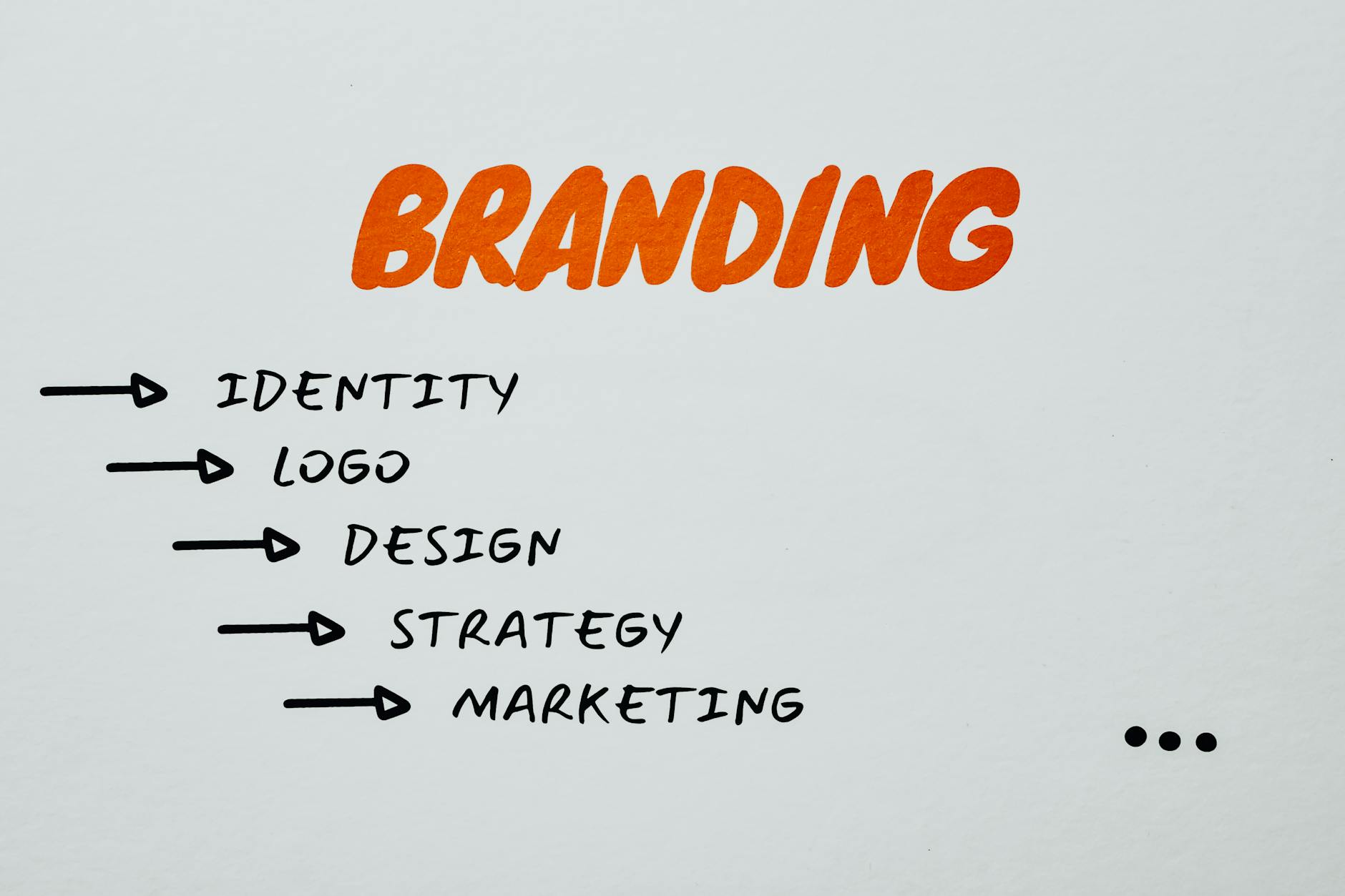Branding Strategies

In today's hyper-competitive marketplace, a strong brand isn't just nice to have - it's essential for survival. Yet, a staggering 73% of businesses fail to stand out in their industry, largely due to ineffective branding. Whether you're a start-up founder or an established business owner, the ability to build and maintain a compelling brand can mean the difference between becoming a household name and fading into obscurity. 🎯
The good news? Strategic branding isn't rocket science, but it is a carefully orchestrated symphony of elements that work together to create lasting impressions. From visual identity to digital presence, every touchpoint matters in telling your brand's unique story. Let's explore the five crucial pillars of successful branding that can transform your business from just another option to the only choice in your customers' minds. ✨

Understanding Brand Fundamentals
Defining Your Brand Identity
Your brand identity is the foundation of your entire business presence. It encompasses your company's core values, mission, personality, and the emotional connection you aim to establish with your customers. A well-defined brand identity helps differentiate your business from competitors and creates a lasting impression in the marketplace.
Key components of brand identity include:
-
Brand Purpose
-
Core Values
-
Brand Voice
-
Brand Personality
-
Visual Elements
-
Brand Promise
Here's a breakdown of how these elements work together:
| Component | Description | Impact |
|---|---|---|
| Brand Purpose | Why your business exists | Drives strategic decisions |
| Core Values | Guiding principles | Shapes company culture |
| Brand Voice | Communication style | Influences customer perception |
| Brand Personality | Human characteristics | Creates emotional connection |
| Visual Elements | Logo, colours, design | Ensures recognition |
| Brand Promise | Customer Commitment | Builds trust |
Creating a Unique Value Proposition
Your unique value proposition (UVP) articulates what sets your brand apart from competitors and why customers should choose you. A compelling UVP addresses three crucial questions:
-
What specific problem does your brand solve?
-
How does your solution differ from alternatives?
-
What unique benefits do customers receive?
To develop a strong UVP:
-
Identify your target market's pain points
-
Analyse competitor offerings
-
Define your unique advantages
-
Articulate benefits clearly and concisely
-
Test and refine based on customer feedback
Your UVP should be:
-
Clear and easy to understand
-
Focused on customer benefits
-
Specific and memorable
-
Authentic to your brand
-
Demonstrably different from competitors
Identifying Target Audience Demographics
Understanding your target audience is crucial for effective brand positioning. Detailed demographic analysis helps create more targeted marketing strategies and better product development decisions.
Key demographic factors to consider:
-
Age Range
-
Gender
-
Income Level
-
Education
-
Geographic Location
-
Occupation
-
Family Status
-
Lifestyle Preferences
Create detailed audience personas using this demographic information:
| Demographic Element | Questions to Answer | Why It Matters |
|---|---|---|
| Age | What age groups benefit most from your product/service? | Influences marketing channels and messaging |
| Income | What pricing aligns with their purchasing power? | Affects product positioning and pricing strategy |
| Location | Where do your potential customers live/work? | Determines distribution and marketing reach |
| Lifestyle | What are their daily habits and preferences? | Shapes product development and marketing approach |
To effectively analyze your target audience:
-
Conduct market research
-
Analyze existing customer data
-
Use social media insights
-
Gather feedback through surveys
-
Monitor the competition's audience
-
Track industry trends
Best practices for audience targeting:
-
Focus on specific segments rather than trying to appeal to everyone
-
Regular update of audience profiles as markets evolve
-
Use data-driven insights to refine targeting
-
Consider psychographic factors alongside demographics
-
Monitor changing consumer behaviors and preferences
With your brand fundamentals established through identity, value proposition, and audience understanding, you're ready to explore how these elements translate into visual brand elements. The visual aspects of your brand will bring these foundational elements to life through design choices that resonate with your target audience.

Visual Brand Elements
Designing an Impactful Logo
A logo serves as the cornerstone of your visual brand identity. The most effective logos combine simplicity with memorability while conveying your brand's core values. Here are the essential elements of impactful logo design:
-
Scalability: Must be recognizable at any size
-
Versatility: Works well in both color and monochrome
-
Uniqueness: Stands out from competitors
-
Timelessness: Avoids trendy elements that may quickly date
-
Relevance: Reflects your industry and brand personality
Consider these successful logotypes:
| Logo Type | Description | Best For |
|---|---|---|
| Wordmark | Text-based design | Brands with strong names |
| Symbol | Iconic graphic | Global/multicultural markets |
| Combination | Text + symbol | Maximum brand recognition |
| Monogram | Letter-based | Long company names |
| Emblem | Contained design | Traditional industries |
Selecting Brand Colors
Color psychology plays a crucial role in brand perception. Your color palette should include:
-
Primary Colors (1-2 colors)
-
Main brand identifier
-
Used in logo and primary materials
-
Secondary Colors (2-3 colors)
-
Supporting elements
-
Creates visual hierarchy
-
Neutral Colors (2-3 colors)
-
Background and text
-
Balances primary and secondary colors
Key considerations for color selection:
| Color Category | Emotional Response | Industry Examples |
|---|---|---|
| Blue | Trust, stability | Finance, technology |
| Green | Growth, nature | Sustainability, health |
| Red | Energy, urgency | Food, retail |
| Yellow | Optimism, youth | Entertainment, Creativity |
| Purple | Luxury, wisdom | Beauty, education |
Typography Selection
Typography hierarchy establishes order and improves readability across all brand materials:
Primary Font:
-
Used for headlines and major titles
-
Reflects brand personality
-
Must be distinctive and legible
Secondary Font:
-
Complementary to the primary font
-
Used for body text and supporting content
-
Prioritizes readability over style
Recommended font combinations:
| Brand Style | Header Font | Body Font |
|---|---|---|
| Modern | Sans-serif geometric | Clean sans-serif |
| Traditional | Serif | Transitional serif |
| Creative | Display | Simple sans-serif |
| Professional | Strong sans-serif | Neutral sans-serif |
Creating Brand Guidelines
Brand guidelines ensure consistency across all touchpoints. Essential components include:
-
Logo Usage
-
Minimum size requirements
-
Clear space rules
-
Approved variations
-
Incorrect usage examples
-
Color Specifications
-
Primary and secondary palettes
-
RGB, CMYK, and Pantone values
-
Color hierarchy and usage rules
-
Typography Rules
-
Font families and weights
-
Size hierarchies
-
Line spacing guidelines
-
Alignment preferences
-
Visual Elements
-
Photography style
-
Illustration guidelines
-
Icon systems
-
Pattern and texture usage
Implementation checklist:
| Component | Internal Use | External Use |
|---|---|---|
| Logo Files | All formats | Selected formats |
| Color Codes | Complete palette | Primary colors |
| Font Files | Full library | Web-safe alternatives |
| Templates | Working files | Finished templates |
A comprehensive brand guidelines document should be:
-
Accessible to all team members
-
Easy to understand and implement
-
Regularly updated
-
Available in digital format
Now that we have established the fundamental visual elements of your brand, we can explore how to effectively implement these across your digital presence.

Digital Brand Presence
Website Optimization
Your website serves as your brand's digital headquarters. A well-optimized website should reflect your brand identity while delivering exceptional user experience. Focus on these key elements:
-
Fast loading speed (under 3 seconds)
-
Mobile responsiveness
-
Clear navigation structure
-
Consistent brand elements
-
Compelling calls-to-action
-
SEO-friendly architecture
| Website Element | Brand Impact | Priority Level |
|---|---|---|
| Homepage Design | First impression | High |
| Navigation Menu | User experience | High |
| Color Scheme | Brand recognition | Medium |
| Typography | Brand personality | Medium |
| Load Time | User retention | Critical |
| Mobile Design | Accessibility | Critical |
Social Media Strategy
Establish a strong social media presence by selecting platforms that align with your target audience. Create a content calendar that maintains consistent posting schedules while adapting content for each platform's unique characteristics:
-
Platform-specific strategies:
-
LinkedIn: Professional content and industry insights
-
Instagram: Visual storytelling and behind-the-scenes
-
Twitter: Real-time engagement and news updates
-
Facebook: Community building and detailed content
-
TikTok: Trendy, authentic short-form videos
-
Content Marketing Approach
Develop a content strategy that positions your brand as an industry authority while providing value to your audience:
-
Content Types:
-
Blog posts
-
Whitepapers
-
Case studies
-
Infographics
-
Video content
-
Podcasts
-
-
Content Distribution:
-
Owned media channels
-
Guest posting opportunities
-
Industry publications
-
Social media platforms
-
Email newsletters
-
Email Marketing Templates
Create branded email templates that maintain visual consistency while serving different purposes:
| Email Type | Purpose | Key Elements |
|---|---|---|
| Welcome Series | Onboarding | Brand story, value proposition |
| Newsletter | Updates | News, blog posts, industry trends |
| Promotional | Sales | Special offers, product highlights |
| Transactional | Operations | Order confirmations, shipping updates |
| Re-engagement | Recovery | Personalized offers, feedback requests |
Design considerations for email templates:
-
Consistent header and footer design
-
Mobile-responsive layout
-
Brand colors and typography
-
Clear call-to-action buttons
-
Optimized image sizes
Online Brand Consistency
Maintain brand consistency across all digital touchpoints to build recognition and trust:
-
Visual Elements:
-
Logo usage guidelines
-
Color palette implementation
-
Typography standards
-
Image style requirements
-
Icon and graphic elements
-
-
Content Guidelines:
-
Brand voice and tone
-
Writing style
-
Messaging framework
-
Response protocols
-
Cultural considerations
-
-
Technical Standards:
-
File naming conventions
-
Image specifications
-
Code documentation
-
Platform-specific requirements
-
Security Protocols
-
Key strategies for maintaining consistency:
-
Create comprehensive brand guidelines
-
Implement approval workflows
-
Use digital asset management systems
-
Conduct regular brand audits
-
Train team members on brand standards
Best practices for digital brand presence:
-
Monitor brand mentions and engagement
-
Respond promptly to customer interactions
-
Update content regularly across platforms
-
Track performance metrics
-
Adapt strategies based on analytics
-
Maintain secure backup systems
Implementation checklist:
-
Develop platform-specific content strategies
-
Create branded template libraries
No comments:
Post a Comment